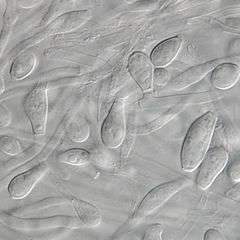Chrysosporium
Chrysosporium is a type of hyaline hyphomycetes fungi in the family Onygenaceae.
| Chrysosporium | |
|---|---|
 | |
| Chrysosporium keratinophilum conidia | |
| Scientific classification | |
| Kingdom: | |
| Phylum: | |
| Class: | |
| Order: | |
| Family: | |
| Genus: | Chrysosporium Corda (1833) |
| Species | |
|
C. baduri Ulfig, Guarro & Vidal-Leir. ined. | |
Chrysosporium colonies are moderately fast-growing, flat, white to tan to beige in color; they often have a powdery or granular surface texture. Hyaline, one-celled (ameroconidia) are produced directly on vegetative hyphae by non-specialized conidiogenous cells. Conidia are typically pyriform to clavate with truncate bases (6 to 7 by 3.5 to 4 um) and are formed either intercalary (arthroconidia), laterally (often on pedicels), or terminally.
Clinical significance
Species of Chrysosporium are occasionally isolated from skin and nail scrapings, especially from feet, but, because they are common soil saprotrophs, they are usually considered as contaminants. There are about 22 species of Chrysosporium, several are keratinophilic with some also being thermotolerant, and cultures may closely resemble some dermatophytes, especially Trichophyton mentagrophytes, and some strains may also resemble cultures of Histoplasma and Blastomyces.
Chrysosporium has been identified as an emerging infectious disease, first in Canada affecting reptiles at around 1995.[1] It infected eastern massasauga rattlesnakes (Sistrurus catenatus catenatus).[2] By 2011, it had affected northern copperheads (Agkistrodon contortrix mokasen), timber rattlesnakes, black rat snakes, black racer snakes and eastern garter snakes in New Jersey.[1]
References
- Michele S. Byers (February 14, 2013). "Fungus is killing off our snakes". The Messenger-Gazette.
- Allender, M. C.; Dreslik, M.; Wylie, S.; Phillips, C.; Wylie, D. B.; Maddox, C.; Delaney, M. A.; Kinsel, M. J. (2011). "Chrysosporiumsp. Infection in Eastern Massasauga Rattlesnakes". Emerging Infectious Diseases. 17 (12): 2383–2384. doi:10.3201/eid1712.110240. PMC 3311193. PMID 22172594.